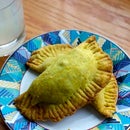Introduction: Peach & Pear Butter
Fruit butters are some of the nicest things to eat. They have a beautiful smooth, spreadable texture, and the long cooking process caramelizes the sugars and brings out deeper flavours hiding in the fruit. Technique wise it’s kind of between making a jam and making caramel. As it cooks, you can see the texture become finer, more translucent and glossy. The colour goes from a light grey-brown to a beautiful deep caramel. Fruit butter takes patience, and a gentle hand, but it’s such a unique taste, and really nice on hot buttery biscuits, or even on top of a pork chop. Oh baby.
I bought a case of fruit just about to go off from the fruit market for $3, so the cost for this project was minimal.
Yield: 1 litre
Time: 2 - 2 1/2 hours
Cost: $
Hardware
- large, heavy bottomed pot
- wooden spoon
- fine mesh seive
- thermometer (optional)
- small plate waiting for you in the freezer (optional)
- jars with resealable, enough to fit 1 litre
Software
- 10 ripe pears
- 10 ripe peaches
- 2 cups brown sugar
- 2 tsp salt
- vanilla Bean (or 2 tsp vanilla extract)
++ You can add ginger, whiskey or cinnamon if you’d like
Step 1: Peel and Chop
Peel, core, and chop 10 pears & 10 peaches.
Step 2: Cook It Down
Peach & Pear Butter
Yield: 1 Litre
Time: 2 hours
Cost: $2.99
10 pears
10 peaches
2 cups brown sugar
2 tsp salt
Vanilla Bean (or 2 tsp vanilla extract)
++ You can add ginger, whiskey or cinnamon if you’d like
** To use for testing if it’s done later on, plate a small plate in the freezer now**
Peel, and dice pears and peaches. Put them in to a large, heavy bottomed pot and add a cup of water.
Cook until soft and breaking down, approximately 15-20 minutes. Puree well in a blender or with an immersion blender. Pour through a mesh sieve into a smaller pot. Press out every bit of juice until you have an almost dry pulp. Set aside.
Put the strained peach+pear mix back on, and bring to a simmer. Add in sugar, salt, and any flavours (except vanilla). Reduce by half on medium-low heat. This will take quite a while, and you should stir it often to prevent the bottom from burning.
The aim is to cook out almost all of the moisture, while simultaneously caramelizing the sugars. You’re looking for nearly 200 degrees on a thermometer. If you take a spoonful out and blob it onto a cold plate, the water shouldn’t separate quickly out of it and drip away.
Your butter should be in a mound on the plate, and if you poke it into a little mountain, it should stay.
Step 3: Test #1
After about 20 minutes of boiling. The liquid separates from the pulp instantly on the plate, and is thin and runny.
Step 4: Test #2
Second spoon test after about 40 minutes. The colour is starting to look nice, but still too runny.
Step 5: Test #3
Third spoon test, after about an hour of cooking. Colour is great and the pulp holds its shape very well. It’s slow to drip, and the liquid that comes out is thicker than before.
Step 6: Test #4
Third spoon test, after about an hour of cooking. Colour is great and the pulp holds its shape very well. It’s slow to drip, and the liquid that comes out is thicker than before.
Step 7:
The mixture is thick and the liquid that comes out is thick and glossy like caramel.
If you push it around the plate a bit, it should make a little mound and hold it's shape.
It should be thick enough to imagine spreading on toast.
Spoon while hot into clean, sterilized jars.













